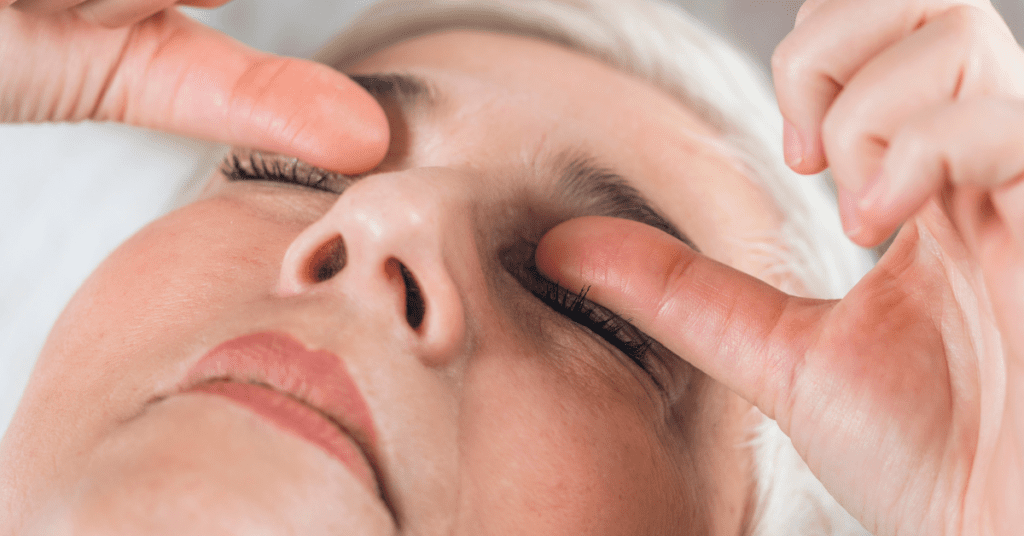Most people only pay attention to their eyes when they have problems, but prolonged exposure to reading, writing, TV, multimedia, mobile, and computer use can also deteriorate eye health. Artificial light exposure is another cause of eye health deterioration. In India, 14 out of 100 students aged over seven years need spectacles. Eye disorders, particularly uncorrected refractive errors, can negatively impact children’s quality of life, vision, education, and psychosocial development. Maintaining optimal eye health is more crucial than ever in a world dominated by screens and artificial lighting. While modern medicine offers effective treatments for various eye conditions, Ayurveda, the Indian system of medicine, provides holistic approaches to promote and preserve ocular well-being.

Ayurveda’s Perspective on Eye Health
Ayurveda emphasizes the importance of the eye as a vital sense organ, as it helps us understand and navigate the world around us. Ayurveda views the eyes as one of the most vital sensory organs, responsible for perceiving light, color, and form. According to Ayurvedic principles, the eyes are governed by the Pitta dosha, representing fire and transformation. When Pitta is in balance, it promotes clear vision and sharp perception. However, imbalances in Pitta can lead to various eye ailments, including dryness, inflammation, and poor vision. Shalakya Tantra, one of the eight clinical specialties of Ashtanga Ayurveda, focuses on eye care and management. Ayurveda identifies three factors responsible for ophthalmic diseases: incompatible contact with visual objects, misuse of intellect, and abnormal seasonal cycles.
Modalities for the promotion of ocular health and prevention of eye diseases:
Maintaining eye health involves a balanced diet, maintaining a healthy weight, regular exercise, wearing protective eyewear, and avoiding smoking. Vedic science offers safe and effective techniques for visual health, which can be practiced in everyday life to prevent lifestyle-related eye disorders.
- Eye Exercises: Ayurveda recommends simple eye exercises to strengthen the ocular muscles, improve circulation, and enhance visual acuity. Palming, blinking, and rotational eye movements are some effective exercises that can be incorporated into daily routines.
- Proper Sleep Hygiene: Adequate sleep is essential for maintaining optimal eye health according to Ayurveda. Establishing a consistent sleep schedule, minimizing screen time before bedtime, and creating a relaxing sleep environment can promote restorative sleep and alleviate eye strain.
- Dinacharya and Pathya Apathya regarding the maintenance of eye health is
vividly described in Ayurveda. The daily regimen can be summarized more realistically as follows:
Eye Wash: Use Lodhra, Amalak, or cold water for constant clear vision. Triphala Eye Wash is a potent Ayurvedic remedy for cleansing and rejuvenating the eyes. Steep Triphala powder in water overnight, strain the solution and use it as an eye wash to alleviate redness, fatigue, and irritation.
Ushajalapana and Nasajalapana: Daily water intake in the early morning to purify the GIT and ensure good vision.
Gandusha: 2-4 mouthfuls of cold water daily to maintain eyesight.
Anjana (collyrium): Two types: Sauveeranjana and Rasananjna, applied daily to eyelashes and used once at intervals for stimulation and secretion.
Snana (Bathing): Bathing with cold water or slightly less than body temperature promotes eye health.
Shiroabhayanga: Daily application of medicated oil on the head strengthens eyes and prevents sense organ disorders.

Panchakarma and Yoga for Eye Care
- Netra Tarpana: Netra Tarpana involves the application of medicated ghee around the eyes to nourish and lubricate the ocular tissues. This practice particularly benefits individuals suffering from dry eyes, eye strain, and degenerative conditions like glaucoma and cataracts.
- Nasya: Anutaila is a method of medicine application to the nasal cavity, specifically to nourish the Nasya organs, which have direct communication with the brain’s sensorineural structures. This treatment improves vision, hearing, smell, and taste, while preserving other sense organs’ integrity.
- Yoga practices, such as Netikirya and Trataka, promote clear eye vision. Palming, a technique in yoga, can relieve eyes and prevent refractive errors. Palming, especially after meals, is useful for preventing Timira, a refractive error and cataract development. Pranayama, or the expansion of Prana’s dimension, is essential for proper eye functioning. A good balance of mental status is crucial for proper functioning of the eyes, as sense organs can only perceive objects in the presence of the mind.
Concluding Recommendations for Healthy Eyes
Eye health promotion involves the use of Rasayanas, such as Naimitika Rasayana in the form of dietary practices and herbal supplements and Achara Rasayana that is improved lifestyle, to maintain healthy eyes and prevent age-related eye disorders. Yastimadhu, Ghrita, and Triphala act as Rasayanas, with Triphala, honey, and ghrita (Ghee) being recommended for strengthening eyesight. Ghrita or plain Ghee and Navaneeta or white butter are rich in vitamins A, choline, Vitamin E, Riboflavin, Niacin, pantothenic acid, Vitamin K, foliate, and vitamin b12. Ayurveda emphasizes maintaining visual health by avoiding diseased components and focusing on daily routines and lifestyle changes. Prevention modalities like Anjana, Nasya, Snana (Bath), Aschyotana, and Padabhyanga are promoted, along with personal, family, and community-level behavior changes, as effective measures for maintaining visual health.
References:
- Patil Y. et al– Study of preventive effect of Pratimarsha Nasya with special reference to Anu Tailam (An ayurvedic preparation), IJRP, ISSN 2230-8407, Vol. 3, Issue 5, 2012.
- Mukhopadhyay, B., Singh, U., & Singh, V. Promotive and Preventive Eye Care in Ayurveda.
- Mane, G. K., Chavan, P., Walvekar, S., Bachate, R. V., Mapari, A. B., Agrawal, V., & Jadhav, S. G. (2020). Promotive and Preventive Eye Care in Ayurveda and Morden view. STUDIES, 6(5).






